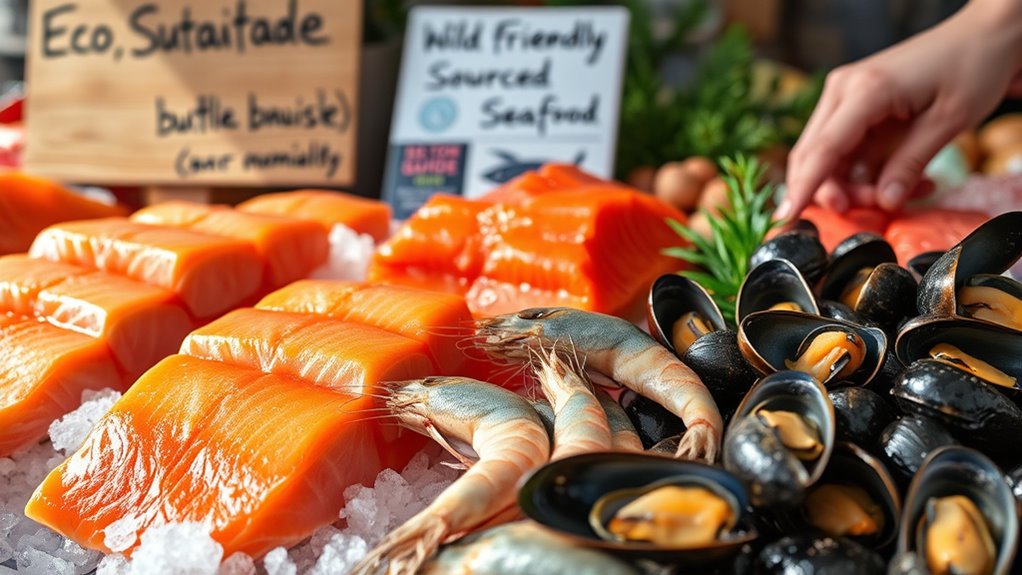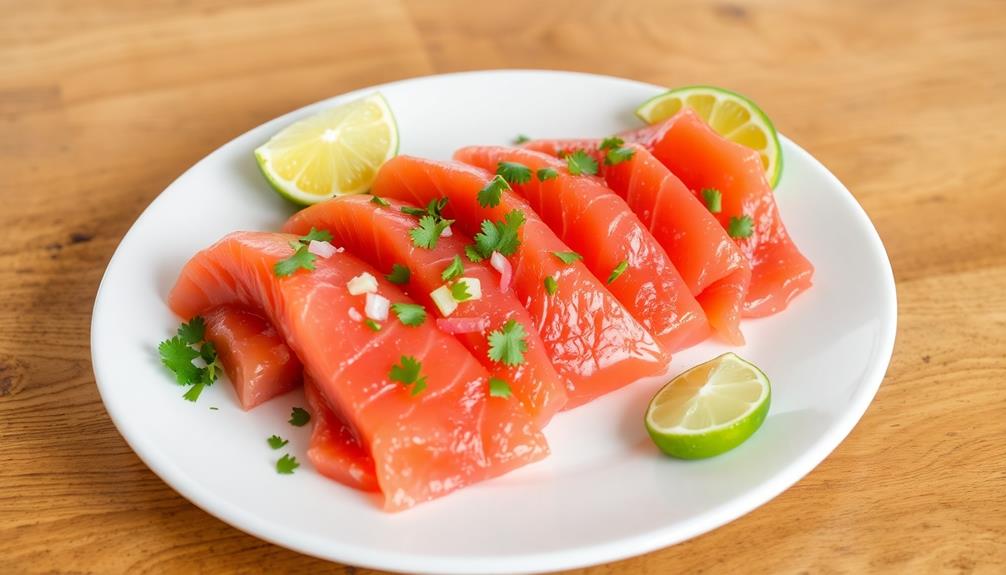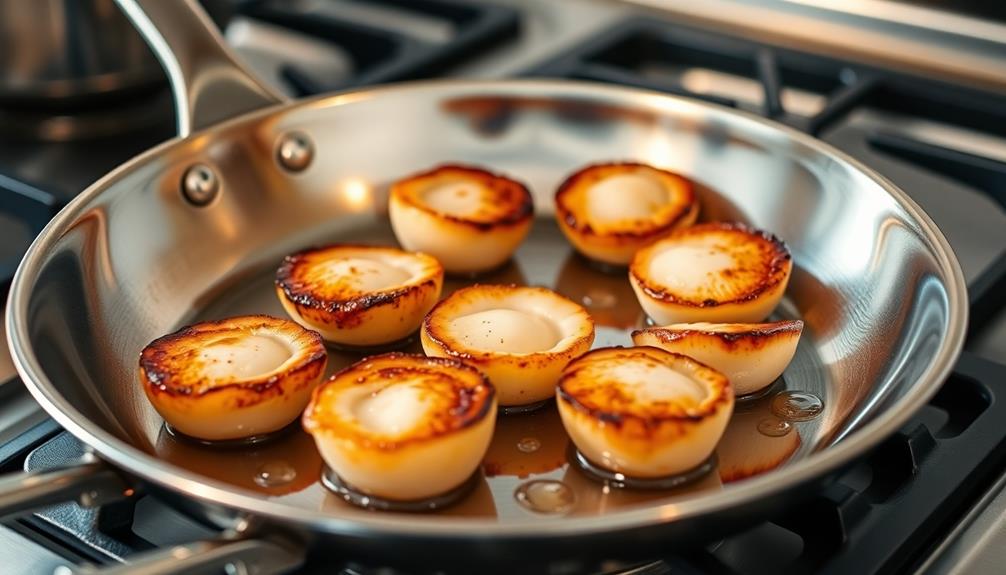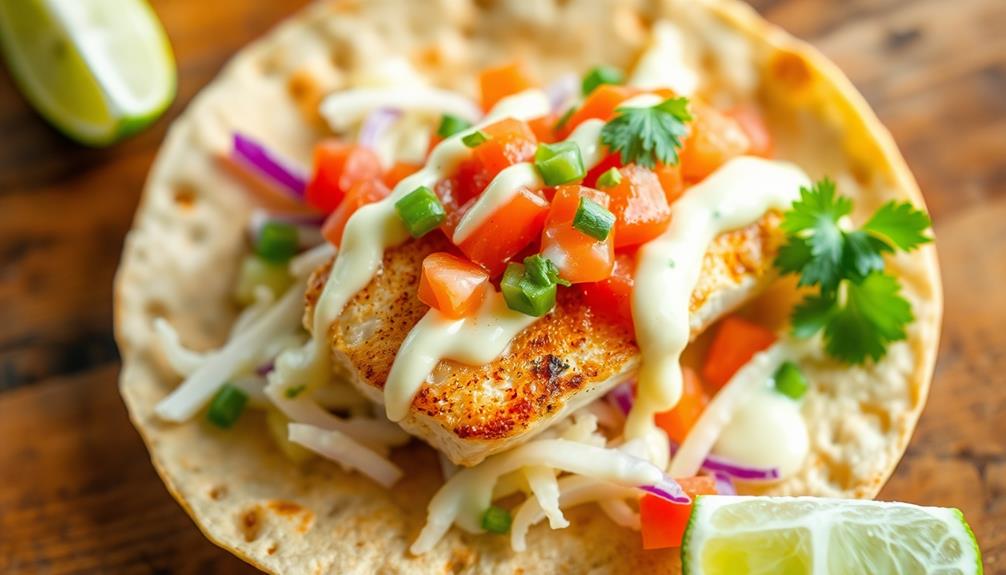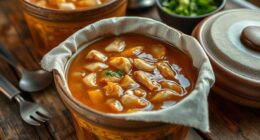To choose sustainable seafood for your bouillabaisse, look for eco labels like MSC or ASC certifications that verify responsible fishing or farming practices. Opt for species that are abundant and less threatened, such as shellfish or monkfish, and avoid overfished or vulnerable types. Use seafood guides or apps to identify eco-friendly options and learn about catching methods that harm ecosystems. If you keep exploring, you’ll discover even more ways to make eco-conscious choices.
Key Takeaways
- Look for eco-labels like MSC or ASC to ensure responsible sourcing.
- Choose species like European conger eel or shellfish that are sustainably harvested.
- Use seafood guides and apps to identify sustainable options suitable for bouillabaisse.
- Avoid overfished or vulnerable species and destructive fishing methods.
- Support transparent sourcing and responsible fishing practices to help marine conservation.

Choosing sustainable seafood is an indispensable step you can take to safeguard ocean ecosystems and guarantee future generations can enjoy seafood. When preparing a traditional dish like bouillabaisse, selecting the right fish is crucial—not just for flavor, but for the health of our oceans. Fish stock sustainability should be your top priority. This means choosing species that are abundant and harvested responsibly, ensuring their populations remain healthy. Overfishing depletes essential stocks, disrupts marine food chains, and threatens the delicate balance of ocean ecosystems. By focusing on fish that are caught or farmed sustainably, you help preserve these stocks for the future.
Prioritize sustainable seafood choices to protect ocean health and support responsible fisheries.
To easily identify sustainable options, look for eco label standards on seafood packaging or at the point of purchase. Labels like the Marine Stewardship Council (MSC) or Aquaculture Stewardship Council (ASC) certify that the seafood has been harvested or farmed in line with strict sustainability criteria. These standards assess factors such as fish stock sustainability, environmental impact, and harvesting methods. When you buy seafood with these eco labels, you’re supporting responsible practices that minimize ecological damage, prevent overfishing, and promote healthier oceans.
In addition to checking labels, educate yourself on the types of fish ideal for bouillabaisse. Typically, traditional recipes call for species like European conger eel, monkfish, or various types of shellfish. Many of these are now available from sustainable sources, especially if you seek out those with verified eco certifications. Avoid species known for overfishing or that are caught using destructive methods, such as trawling that damages seabeds. Instead, opt for alternatives that are abundant and responsibly harvested, which helps maintain a balanced ecosystem. Incorporating sustainable fishing practices into your choices can further support marine conservation efforts. Incorporating digital asset management tools can also help consumers access detailed information about sustainable seafood sources.
It’s also wise to consult resources like seafood guides or apps that rate the sustainability of different species and their sources. These tools can help you navigate the confusing array of options and make informed decisions. Additionally, understanding the importance of active consumer involvement can empower you to advocate for better fisheries management. Remember, choosing seafood with transparent sourcing and eco label standards supports sustainable fisheries and reduces pressure on vulnerable fish stocks. This way, you’re not just preparing a delicious bouillabaisse, but also contributing to the health of our oceans.
Frequently Asked Questions
What Are the Best Sustainable Seafood Certifications to Look For?
When selecting sustainable seafood, you should look for certification standards that guarantee responsible practices. Certifications like the Marine Stewardship Council (MSC) and Aquaculture Stewardship Council (ASC) focus on sustainable aquaculture practices and wild-caught fisheries. These standards help you identify seafood that adheres to environmentally friendly aquaculture practices, protecting ecosystems and fish populations. By choosing products with these certifications, you support responsible fishing methods and promote healthier oceans.
How Can I Tell if Seafood Is Sustainably Sourced When Shopping?
When shopping for seafood, you can tell if it’s sustainably sourced by paying attention to seafood labeling. Look for certifications like MSC or ASC, which indicate responsible fishing practices. Also, check the fishing methods listed; methods like handline or pole-and-line are more sustainable than trawling or gillnetting. By being mindful of labeling and fishing methods, you help support environmentally friendly seafood options.
Are Farmed Seafood Options More Sustainable Than Wild-Caught?
Think of seafood choices like a garden—some plants are carefully tended in controlled environments, while others grow wild. Farmed seafood, depending on aquaculture practices, can be sustainable if managed well, reducing pressure on wild fisheries. Wild fisheries management aims to keep populations healthy, but overfishing remains a concern. When choosing, research methods, certifications, and local practices to guarantee your seafood supports both healthy oceans and responsible farming.
What Seasonal Seafood Choices Support Sustainability?
When selecting seafood, focus on seasonal options to support sustainability benefits. Seasonal seafood is harvested at peak times, reducing environmental impact and ensuring freshness. By choosing fish that are in season locally, you help maintain healthy fish populations and reduce overfishing. This practice also minimizes the carbon footprint associated with transportation. Embracing seasonal seafood not only benefits the environment but also enhances the flavor and quality of your bouillabaisse.
How Does Seafood Transportation Impact Its Sustainability?
Seafood transportation can be a game-changer for sustainability—imagine your fish’s journey from ocean to plate stretching across the globe! Shipping methods like air freight massively boost the carbon footprint, while local or ship-based options drastically cut emissions. By choosing seafood transported via eco-friendly methods, you help shrink the environmental impact, making your bouillabaisse not just tasty but a smarter, greener choice for the planet.
Conclusion
By prioritizing playful, responsible, and reputable choices, you’ll prepare a bouillabaisse that’s both beautiful and sustainable. Remember to research, select, and support seafood sources that stand for stewardship and sustainability. Your mindful menu can make a mighty difference, making each bite a bold, balanced celebration of the sea’s bounty. So, savor your sustainable seafood with a sense of pride, passion, and purpose—because every conscientious choice counts in conserving our coastal creatures and crabbing communities.
